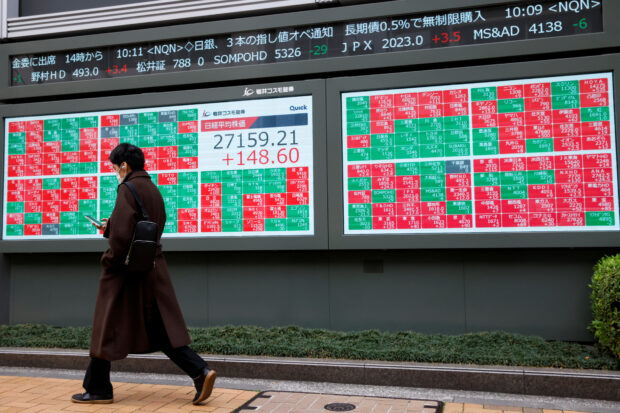
A man walks past an electronic board showing Japan’s Nikkei average and stock prices outside a brokerage, in Tokyo, Japan, March 17, 2023. REUTERS/Androniki Christodoulou/File photo
HONG KONG, China – Asian and European markets bounced Tuesday from the previous day’s rout, with lenders boosted by easing concerns of another financial crisis, while focus turned to the Federal Reserve’s policy decision later in the week.
The panic that characterized trade over the past 11 days appeared to have faded after authorities in leading economies pledged support for depositors and troubled banks following the collapse of Silicon Valley Bank and Signature Bank in the United States.
Still, the takeover of troubled Credit Suisse by UBS for $3.25 billion fanned concerns about what could be next on the chopping block, and analysts warned it was too early to say that the crisis was over.
The move to save Credit Suisse aimed to prevent a wider crisis as it is among the 30 global banks considered “too big to fail”.
All three main indexes on Wall Street ended on the front foot — with the Dow more than one percent up — while European markets were also comfortably higher, helped by promises of support from the Fed and other central banks as well as the saving of Credit Suisse.
Wall St ends higher as bank contagion fears ease, Fed eyed
However, embattled First Republic Bank collapsed almost 50 percent, despite a coalition of US lenders saying they would inject $30 billion into it.
But CMC Markets analyst Michael Hewson said: “The problems being felt in the US banking system were being shrugged off with further weakness in First Republic Bank being treated as a localized difficulty, rather than anything more systemic.”
There was also less concern over high-risk debt markets as holders of such bonds at Credit Suisse, known as AT1s, will lose $17.3 billion after authorities required that they be written off.
Why markets are in uproar over a risky bank bond known as AT1
The assets, also known as “CoCo” bonds, tumbled Monday as they were wiped out in the deal despite equity investors getting some of their cash back. That led traders to question the usual hierarchy of bonds over stocks.
However, European officials on Monday reiterated that the usual structure remained the same for claims.
Dollar tumbles
The upheaval in the banking sector has led traders to reevaluate their bets on the Fed’s interest rate plans, with speculation swirling that it will even cut rates by the end of the year to provide some stability, despite still-elevated inflation.
Dollar languishes as bank crisis fears ebb on Credit Suisse rescue
Before the crisis kicked off, expectations were for borrowing costs to go as high as six percent, but now forecasts are for them to end at around four percent.
They are currently at 4.5-4.75 percent, and there is much talk about whether the US central bank holds fire at its Wednesday decision or lifts rates by 25 basis points.
“Given the uncertainty in US regional Main Street banks, who do the bulk of the heavy lifting in consumer, small business and agricultural loans across America’s heartland, there is a good chance the Fed prioritizes stability over inflation this meeting,” said SPI Asset Management’s Stephen Innes.
“And with oil tanking in the first quarter, the inflation problem could look relatively less urgent for this meeting.
“The good news is that the headline has fallen for eight consecutive months; the bad news is that 5.5 percent on the core is still far from the target. To be clear: US inflation is still a serious issue, and it’s not coming down as fast as most expected.”
And Ed Yardeni, of Yardeni Research, said: “Further rate hikes are no longer warranted, in our opinion.”
Hong Kong rose Tuesday, with lenders HSBC and Standard Chartered well up, while Shanghai, Singapore, Seoul, Taipei, Manila, Mumbai, Bangkok and Jakarta were also in positive territory.
Sydney rallied thanks to advances for National Australia Bank and Westpac.
London, Paris and Frankfurt were also boosted by rallies in banks in opening trade.
Lower expectations for US interest rates were also weighing on the dollar, which has tumbled against its peers and struggled to recover Tuesday, while oil prices fell again as investors fret over the impact on demand from a possible recession.